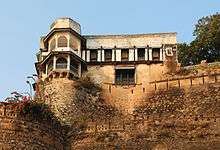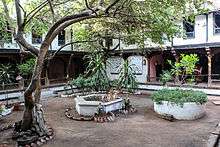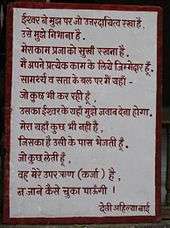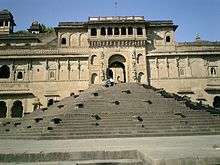Ahilyabai Holkar
| Maharani Ahilya Bai Holkar महाराणी अहिल्या बाई होळकर | |||||
|---|---|---|---|---|---|
| Her Highness Maharani Shrimant Akhand Soubhagyavati Ahilya Bai Sahiba | |||||
 | |||||
| Queen of the Malwa Kingdom | |||||
| Reign | 1 December 1767 – 13 August 1795 | ||||
| Coronation | 11 December 1767 | ||||
| Predecessor | Malerao Holkar | ||||
| Successor | Tukojirao Holkar I | ||||
| Born |
31 May 1725 Grram Chaundi, Jamkhed, Ahmednagar, Maharashtra, India | ||||
| Died | 13 August 1795 | ||||
| Spouse | Khanderao Holkar | ||||
| |||||
| House | House of Holkar | ||||
| Dynasty | Maratha Confederacy | ||||
| Father | Mankoji Shinde | ||||
| Religion | Hindu | ||||
Maharani Ahilya Bai Holkar (31 May 1725 – 13 August 1795) was the Holkar Queen of the Maratha ruled Malwa kingdom, India. Rajmata Ahilyabai was born in the village of Chondi in Jamkhed, Ahmednagar, Maharashtra. She moved the capital to Maheshwar south of Indore on the Narmada River.
Ahilyabai's husband Khanderao Holkar was killed in the battle of Kumbher in 1754. Twelve years later, her father-in-law, Malhar Rao Holkar, died. A year after that she was crowned as the queen of the Malwa kingdom. She tried to protect her kingdom from plundering Muslim invaders. She personally led armies into battle. She appointed Tukojirao Holkar as the Chief of Army.
Rani Ahilyabai was a great builder and patron of many Hindu temples which embellished Maheshwar and Indore. She also built temples and Dharmshala (free lodging) at sacred sites outside her kingdom, at prominent religious places like Dwarka in Gujarat east to the Kashi Vishwanath Temple at Varanasi on the Ganges, Ujjain, Nasik, Vishnupad Mandir, Gaya and Parali Baijnath in Maharashtra. Seeing the destroyed and desecrated temple in Somnath, Rani Ahilyabai built a temple where Lord Shiva is still worshipped by Hindus.
Early life
Ahilyabai was born on 31 May 1725 in the village of Chaundi, in the present-day Ahmednagar district in Maharashtra. Her father, Mankoji Rao Shinde, was the Patil of the village. Women then did not go to school, but Ahilyabai's father taught her to read and write.
Her entrance on to the stage of history was something of an accident: Malhar Rao Holkar, a commander in the service of the Maratha Peshwa Bajirao and lord of the Malwa territory, stopped in Chaundi on his way to Pune and, according to legend, saw the eight-year-old Ahilyabai at the temple service in the village. Recognising her piety and her character, he brought the girl to the Holkar territory as a bride for his son, Khanderao (1723–1754). She was married to Khanderao in 1733.
Reign



Ahilya Bai’s husband Khanderao was killed during the siege of Kumbher in 1754. Twelve years later, her father-in-law, Malharrao died. Malharrao was succeeded by Malerao, the only son of Khanderao, but he also died on 5 April 1767. From 1767 until her death in 1795, she ruled Malwa, trained in both administrative and military matters by Malhar Rao. A letter to her from her father-in-law Malhar Rao in 1765 illustrates the trust he had in her ability during the tempestuous battle for power in the 18th century:
- "Proceed to Gwalior after crossing the Chambal. You may halt there for four or five days. You should keep your big artillery and arrange for its ammunition as much as possible….On the march you should arrange for military posts being located for protection of the road."
Already trained to be a ruler, Ahilyabai petitioned the Peshwa after Malhar’s death, and the death of her son, to take over the administration herself. Some in Malwa objected to her assumption of rule, but the army of Holkar was supported her leadership. She led them in person, with four bows and quivers of arrows fitted to the corners of the howdah of her favourite elephant. The Peshwa granted her permission on 11 December 1767, and, with Subhedar Tukojirao Holkar (Malharrao's adopted son) as the head of military matters, she proceeded to rule Malwa in a most enlightened manner, even reinstating a Brahmin who had opposed her. Ahilyabai never observed purdah but held daily public audience and was always accessible to anyone who needed her ear.
Among Ahilyabai's accomplishments was the development of Indore from a small village to a prosperous and beautiful city; her own capital, however, was in nearby Maheshwar, a town on the banks of the Narmada river. She also built forts and roads in Malwa, sponsored festivals and gave donations for regular worship in many Hindu temples. Outside Malwa, she built dozens of temples, ghats, wells, tanks and rest-houses across an area stretching from the Himalayas to pilgrimage centres in South India. The Bharatiya Sanskritikosh lists as sites she embellished, Kashi, Gaya, Somnath, Ayodhya, Mathura, Hardwar, Kanchi, Avanti, Dwarka, Badrinarayan, Rameshwar and Jaganathpuri. Ahilyadevi also supported the rise of merchants, farmers and cultivators to levels of affluence, and did not consider that she had any legitimate claim to their wealth, be it through taxes or feudal right.
There are many stories of her care for her people. In one instance, when her minister refused to allow the adoption unless he was suitably bribed, she is said to have sponsored the child herself, and given him clothes and jewels as part of the ritual. To honour the memory of Ahilyadevi Holkar, in 1996 leading citizens of Indore instituted an award in her name to be bestowed annually on an outstanding public figure. The Prime Minister of India gave away the first award to Nanaji Deshmukh.
Ahilyadevi was not able to settle the conflict peacefully in the case of the Bhils and Gonds, who plundered her borders; but she granted them waste hilly lands and the right to a small duty on goods passing through their territories. Even in this case, according to Malcolm, she did give "considerate attention to their habits".
Ahilyabai’s capital at Maheshwar was the scene of literary, musical, artistic and industrial enterprise. She entertained the famous Marathi poet, Moropant and the shahir, Anantaphandi from Maharashtra, and also patronised the Sanskrit scholar, Khushali Ram. Craftsmen, sculptors and artists received salaries and honours at her capital, and she even established a textile industry in the city of Maheshwar.
After her death, she was succeeded by Tukojirao Holkar I, her commander-in-chief, who soon abdicated the throne in favour of his son Kashirao Holkar in 1797.
Views about her

"The reign of Ahilyabai, of Indore in central India, lasted for 30 Yrs. This has become almost legendary as a period during which perfect order and good Government prevailed and the people prospered. She was a very able ruler and organizer, highly respected during her lifetime, and considered as a saint by a grateful people after her death."[1]
An English poem written by Joanna Baillie in 1849 reads:[2]
"For thirty years her reign of peace,
The land in blessing did increase;
And she was blessed by every tongue,
By stern and gentle, old and young.
Yea, even the children at their mothers feet
Are taught such homely rhyming to repeat
"In latter days from Brahma came,
To rule our land, a noble Dame,
Kind was her heart, and bright her fame,
And Ahlya was her honoured name."
"The Great Dhangar Maratha lady who affords the noblest example of wisdom, goodness and virtue. One english writer quoted that which Akbar is among male sovereigns, is Ahlia Baie among female sovereigns".[3]
"Ahilyabai's extraordinary ability won her the regard of her subjects and of the other Maratha confederates, including Nana Phadnavis. Collecting oral memories of her in the 1820s, Sir John Malcolm, the British official most directly concerned with the 'settlement' of central India, seems to have become deeply enamourned of her. "With the natives of Malwa ... her name is sainted and she is styled an avatar or Incarnation of the Divinity. In the most sober view that can be taken of her character, she certainly appears, within her limited sphere, to have been one of the purest and most exemplary rulers that ever existed".[4] Her latest biographers call her 'The Philosopher Queen', a reference perhaps to the 'Philosopher king' Bhoj."[5] "Ahilyabai Holkar, the 'philosopher-queen' of Malwa, had evidently been an acute observer of the wider political scene. In a letter to the peshwa in 1772 she had warned against association with the British, and likened their embrace to a bear-hug: "Other beasts, like tigers, can be killed by might or contrivance, but to kill a bear it is very difficult. It will die only if you kill it straight in the face, Or else, once caught in its powerful hold, the bear will kill its prey by tickling. Such is the way of the English. And in view of this, it is difficult to triumph over them."[6] "This great ruler in Indore encouraged all within her realm to do their best, Merchants produced their finest cloths, trade flourished, the farmers were at peace and oppression ceased, for each case that came to the queens notice was dealt with severely. She loved to see her people prosper, and to watch the fine cities grow, and to watch that her subjects were not afraid to display their wealth, lest the ruler should snatch it from them. Far and wide the roads were planted with shady trees, and wells were made, and rest-houses for travellers. The poor, the homeless, the orphaned were all helped according to their needs. The Bhils who had long been the torment of all caravans, were routed from their mountain fastnesses and persuaded to settle down as honest farmers. Hindu and Musalman alike revered the famous Queen and prayed for her long life. Her last great sorrow was when her daughter became a Sati upon the death of Yashwantrao Phanse. Ahalya Bai was seventy years old when her long and splendid life closed. Indore long mourned its noble Queen, happy had been her reign, and her memory is cherished with deep reverence unto this day.[7] "From the original papers and letters, it becomes clear that she was first-class politician, and that was why she readily extended her support to Mahadji Shinde. I have no hesitation in saying that without the support of Ahilyabai, Mahadji would never have gained so much importance in the politics of northern India."[8]
"Definitely no woman and no ruler is like Ahilyabai Holkar."[9]
"It reveals beyond doubt that all ideal virtues described by Plato and Bhismacharya were present in her personality like Dilip, Janak, Shri Ram, Shri Krishna and Yudhishthir. After through scrutiny of the long history of the world we find only one personality of Lokmata Devi Ahilya that represents an absolutely ideal ruler."[10]
A commemorative stamp[11] was issued in her honour on 25 August 1996 by the Republic of India.
As a tribute to the great ruler, Indore domestic airport has been named Devi Ahilyabai Holkar Airport. Similarly, Indore university has been renamed as "Devi Ahilya Vishwavidyalaya".
Works throughout India



It was the speciality of Holkar family that they did not use public funds to meet their personal and family expenses. They had their personal fund from their private property. Ahilyabai inherited personal funds which at that time was estimated to be sixteen crores rupees. Ahilyabai used personal fund in charitable works.[12]
- Alampur (MP) – Harihareshwar, Batuk, Malharimarthand, Surya, Renuka, Ram Hanuman Temples, Shriram Temple, Laxmi Narayan Temple, Maruti Temple, Narsinh Temple, Khanderao Martand Temple, Memorial of Malharrao (I)
- Amarkantak- Shri Vishweshwar Temple, Kotithirth Temple, Gomukhi Temple, Dharamshala, Vansh Kund
- Ambegaon – Lamps for temple
- Anand Kanan – Vishweshwar Temple
- Ayodhya (U.P)– Built Shri Ram Temple, Shri Treta Ram Temple, Shri Bhairav Temple, Nageshwar/Siddhnath Temple, Sharayu Ghat, well, Swargadwari Mohatajkhana, Dharamshalas
- Badrinath (Uttarakhand) – Badrinath Temple, Shri Kedareshwar and Hari Temples, Dharamshalas (Rangdachati, Bidarchati, Vyasganga, Tanganath, Pawali), Manu kunds (Gaurkund, Kundachatri), Garden and Warm Water Kund at Dev Prayag, Pastoral land for cows
- Beed – Jirnnodhar of a Ghat.
- Belur (Karnataka) – Ganpati, Pandurang, Jaleshwar, Khandoba, Tirthraj and Fire temples, Kund
- Bhanpura – Nine Temples and Dharmashala
- Bharatpur – Temple, Dharmashala, Kund
- Bhimashankar – Garibkhana
- Bhusawal – Changadev Temple
- Bitthur – Bhramaghat
- Burhanpur (MP) – Raj Ghat, Ram Ghat, Kund
- Chandwad – Vishnu Temple and Renuka Temple
- Chaundi – Chaudeshwaridevi Temple, Sineshwar Mahadev temple,
- Ahilyeshwar Temple, Dharamshala, Ghat,
- Chitrakoot – Pranpratishta of Shri Ramchandra
- Cikhalda – Annakshetra
- Dwarka (Gujarat) – Mohatajkhana, Pooja House and gave some villages to priest
- Gangotri – Vishwanath, Kedarnath, Annapurna and Bhairav Temples, many Dharmashalas
- Gaya (Bihar) – Vishnupad Temple
- ((Gokarna)) – Rewaleshwar Mahadev temple, Holkar wada, Garden and Garibkhana
- Grishneshwar – Shiva temple and Shivalaya Tirth
- Handiya – Siddhanath Temple, ghat and dharmashala
- Haridwar (Uttarakhand) – Kushawarth Ghat and a Huge Dharmashala
- Indore – Many Temples and ghats
- Jalgaon – Ram Mandir
- Jamghat – Bhumi dwar
- Jamvgaon – Donated for Ramdas swami Math
- Jejuri – Malhargautameshwar, Vitthal, Martand Temple, Janai Mahadev and Malhar lakes
- Karmanasini River – Bridge
- Kedarnath – Dharmashala and Kund
- Kolhapur – Facilities for temple pooja
- Kumher – Well and Memorial of Prince Khandera
- Khargone – fort and many temples and ghats
- Kurukshetra (Haryana) – Shiv Shantanu Mahadev Temple, Panchkund Ghat, Laxmikund Ghat
- Maheshwar – Hundreds of temples, ghats, dharmashalas and houses
- Mamaleshwar Mahadev Himachal Pradesh – Lamps
- Manasa Devi – Seven temples
- Mandaleshwar – Shiv Temple Ghat
- Mangaon – Datta Mandir, Near Sawantwadi, Konkan, Maharashtra, India
- Miri (Ahmednagar) – Bhairav Temple in 1780
- Naimabar(MP) – Temple
- Nandurbar – Temple, Well
- Nathdwara – Ahilya Kund, Temple, Well
- Neelkantha Mahadev – Shivalaya and Gomukh
- Nemisharanya(UP) – Mahadev Madi, Nimsar Dharmashala, Go-ghat, Cakrithirth kund
- Nimgaon (Nashik) – Well
- Omkareshwar (MP) – Mamaleshwar Mahadev, Amaleshwar, Trambakeshwar Temples (Jirnnodhar), Gauri Somnath Temple, Dharmashalas, Wells
- Ozar (Ahmednagar) – 2 wells and kund
- Panchavati, Nasik – Shri Ram Temple, Gora Mahadev temple, Dharmashala, Vishweshwar Temple, Ramghat, Dharmashala
- Parli Vaijnath – Shri Vaidyanath Mandir
- Pandharpur (Maharashtra) – Shri Ram Temple, Tulsibag, Holkar wada, Sabha Mandap, Dharmashala and gave silver utensil for the Vitthal Temple, Pandharpur, Well-Which known by Bagirao well.
- Pimplas (Nashik) – well
- Prayag (Allahabad UP) – Vishnu Temple, Dharmashala, Garden, Ghat, Palace
- Pune – Ghat
- Puntambe (Maharashtra) – Ghat on Godavari river
- Puri (Odisha) – Shri Ramchandra Temple, Dharmashala and Garden
- Pushkar – Ganpati Temple, Dharmashala, Garden
- Rameswaram (TN) – Hanuman Temple, Shri Radha Krishna Temple, Dharmashala, Well, Garden etc.
- Rampura – Four Temples, Dharmashala and houses
- Raver – Keshav Kund
- Rishikesh – Many temples including Shrinathji and Govardhan ram temples
- Sakargaon – well
- Sambhal – Laxmi Narayan Temple and two wells
- Sangamner – Ram Temple
- Saptashrungi – Dharmashala
- Sardhana Meerut – Chandi Devi Temple
- Saurashtra (Guj) – Somnath Temple in 1785. (Jirnnodhdhar and Pran Prathistha)
- Siddhivinayak temple's inner sanctum at Siddhatek in Ahmednagar District
- Shri Nagnath (Darukhvan) – Started pooja in 1784
- Srisailam (AP) – Mallikarjuna Swamy Temple
- Shri Shambhu Mahadev Mountain Shingnapur (Maharashtra) – Well
- Shri Vighneshwar – Lamps
- Sinhpur – Shiv Temple and ghat
- Sulpeshwar – Mahadev Temple, annakshetra
- Sultanpur (Khandesh) – Temple
- Tarana – Tilabhandeshwar Shiv temple, Khedapati, Shriram Temple, Mahakali Temple
- Tehari (Bundelkhand) – Dharmashala
- Trimbakeshwar (Nashik) – Bridge on Kushawarth Ghat
- Ujjain (MP) – Chintaman Ganapati, Janardhan, Shrilila urushottam, Balaji Tilakeshwar, Ramjanaki Ras Mandal, Gopal, Chitnis, Balaji, Ankpal, Shiv and many other temples, 13 ghats, well and many Dharmashalas etc.
- Varanasi – Kashi Vishwanath Temple (1780[13]), Shri Tarakeshwar, Shri Gangaji, Ahilya Dwarkeshwar, Gautameshwar, Many Shiva Temples; Ghats including Manikarnika Ghat, Dashashwamedh Ghat, Janana Ghat, Ahilya Ghat, Shitala Ghat; UttarKashi Dharmashala, Rameshwar Panchkoshi Dharmashala, Kapila Dhara Dharmashala,
- Vrindavan (Mathura) – Chain Bihari Temple, Kaliyadeha Ghat, Chirghat and many other ghats, Dharmashala, Annakstra
- Wafgaon (Rajgurunagar, Pune) – Holkar wada and one well
- Ambad (maharashtra) -Matsodari Devi Mandir
- Vikharan (Shirpur Dist:Dhule maharashtra) Well
Book
- In Marathi
- Punyashlok Ahilya by R.W.Tikore-Kumthewale
- Ahilyabai by Hiralal Sharma
- Ahilyabai Charitra by Purshottam
- Ahilyabai Charitra by Mukund Vaman Barve
- Karmayogini by Vijaya Jahagirdar
- Dnyat Adnyat Ahilyabai Holakar by Vinaya Khadapekar
- Pal Samaaj on Samaaj
In popular culture
- A film titled Devi Ahilya Bai was produced in 2002 featuring Mallika Prasad as Devi Ahilya Bai, Shabana Azmi as Harkubai (Khaanda Rani, one of Malhar Rao Holkar's wives) and also including Sadashiv Amrapurkar as Malhar Rao Holkar, Ahilyabai's father in law.[14]
- A documentary for UGC-CEC channel VYAS was made by Educational Multimedia Research Centre, Indore about her life and times.
- In Thane City in Maharashtra, a children's play park has been named as 'Ahilyadevi Holkar Udyan' after her. Also a road has been named after her in the same city.
- The airport at Indore is named Devi Ahilyabai Holkar Airport in her honour.
See also
References
- ↑ Jawaharlal Nehru:Discovery of India, 2004, page-304
- ↑ English poem written by Jaonna Baillie, London, 1849.
- ↑ Quote of an English writer given in the Book Ahilya Bai Holkar by Khadpekar
- ↑ Malcolm, J., A Memoir of Central India, quoted in Kamath, M. B. and Kher, V. B., Devi Ahalyabai Holkar: The Philosopher Queen, p.85 and Quoted in John Keay, India: A History, p. 407
- ↑ John Keay, India: A History, p. 407, Gordon, S., The Marathas etc., p. 162
- ↑ John Keay, India: A History, p.425. reference of Sardesai, G. S., Marathi Riyasat, Bombay, 1925, quoted in Kamath, M. B. and Kher, V. B., Devi Ahalyabai Holkar: The Philosopher Queen, p.126 and Quoted in
- ↑ Dr. Annie Besant, Ahalyabai – A Great Ruler, Children of the Mother Land, Page 290-291.
- ↑ Renowned Historian Mr. Judunath Sarkar
- ↑ Nizam of Hyderabad.
- ↑ Arvind Javlekar, Lokmata Ahilyabai. p. 140
- ↑ "Ahilyabai Holkar". Indianpost.com. 25 August 1996. Retrieved 17 September 2012.
- ↑ Arvind Javlekar, Lokmata Ahilyabai. 2005. p. 62.
- ↑ "Shri Kashi Vishwanath Temple – A Brief history".
- ↑ "NFDC: Cinemas of india". Nfdcindia.com. Retrieved 17 September 2012.
External links
| Wikimedia Commons has media related to Vishnupad Mandir. |